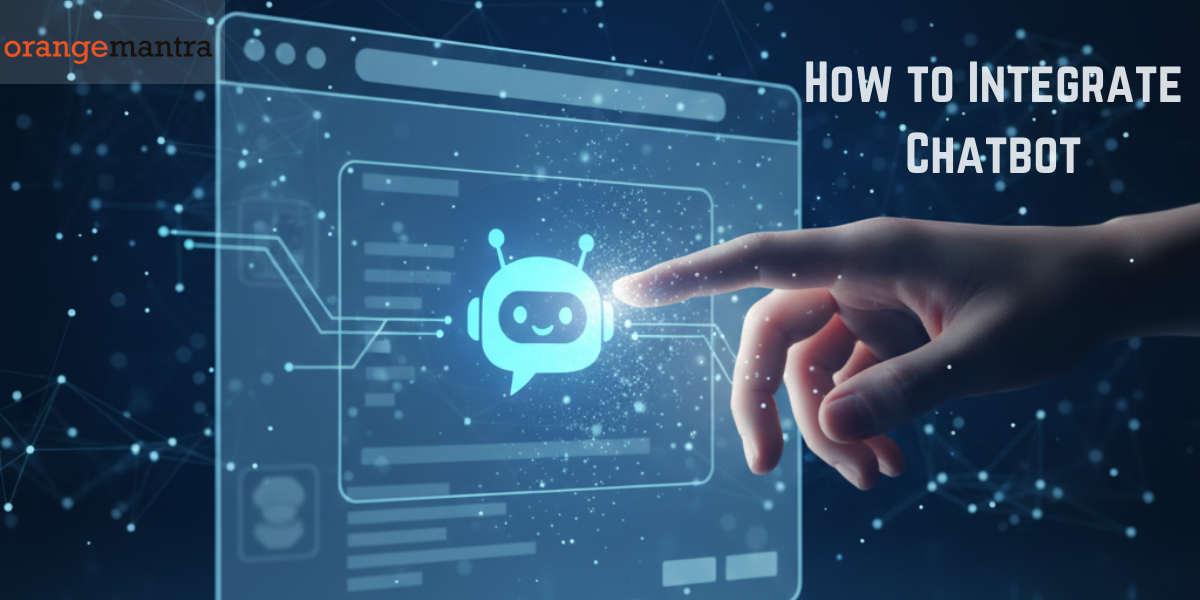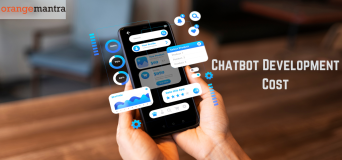
Integrating an AI chatbot into your website is one of the fastest ways to boost engagement, reduce support load, and improve conversions. This guide explains the step-by-step process, costs, tools, best practices, and 2025 trends to help you successfully add a chatbot to any website.
Here’s what you will learn:
- How modern chatbots work and why websites need them
- Step-by-step chatbot integration for any platform
- Best tools to build and deploy AI chatbots
- How to embed chatbot scripts on WordPress, Shopify, and custom sites
- Cost breakdown for rule-based and AI chatbots
- How WhatsApp chatbot integration works
- Common mistakes to avoid during implementation
- Real examples of chatbot ROI and performance
- 2025 trends shaping chatbot technology
Have you ever given it a thought as to why most websites greet you and ask, “How can I help you?” Well, let me tell you that this is a chatbot assistant, specifically designed to engage visitors to the websites in real time.
As we all know that the businesses are rapidly shifting towards overall automation as well as personalization, it is important for you to get an overall understanding of the steps of how to integrate AI chatbot services in websites, which is a crucial factor.
Chatbots have evolved from just answering requirement-based questions to recommending products, capturing leads, and even closing sales.
In this blog, we’ll walk you through a complete step-by-step process on how to integrate a chatbot into a website for 2025.
Table of Contents
What Is a Chatbot and Why Is It Important for Modern Websites?
A chatbot for a website can provide information, process requests, and enhance customer experience 24/7. There are two main types of chatbots:
| Type | Description | Use Case |
| Rule-based Chatbot | Operates on predefined commands and conditions. | Navigation assistance. |
| AI Chatbot | Use NLP and ML to understand and respond contextually. | Product recommendations, customer support, or lead nurturing. |
When you add an AI chatbot to a website, you create a personalized experience that keeps users engaged while reducing support costs. It also improves conversions—studies show that chatbots can increase lead capture rates by up to 40%.
Integrating an AI-powered chatbot for a website means your users get instant support, even after business hours—a big competitive advantage in 2025.
For eCommerce owners, choosing an AI chatbot for websites, especially for eCommerce, helps not only with customer support but also with upselling products and recovering abandoned carts.
Step-by-Step Guide: How to Integrate an AI Chatbot into a Website
Integrating a chatbot doesn’t require advanced coding. Whether you’re building a WhatsApp chatbot for a website or a web-based one, the process remains simple and structured.
Step 1: Choose the Right Chatbot Platform
The first step is selecting a platform that matches your business needs. Below is a quick comparison of the top chatbot tools for 2025:
| Platform | Key Features | Best For | Free Plan |
| Dialog flow (Google) | AI-based NLP, multi-language support | Complex conversational bots | ✔ |
| Tidio | eCommerce automation, live chat | Online stores | ✔ |
| Many Chat | WhatsApp and Messenger integration | Social selling | ✔ |
| HubSpot Chatbot | CRM integration, lead tracking | B2B websites | ✔ |
| Drift | AI sales assistant | SaaS & enterprise | ❌ |
When choosing, consider whether the platform supports AI chatbot integration in the website through scripts or plugins.
Step 2: Set Up the Chatbot
Once your tool is selected:
- Create an account and access the chatbot builder dashboard.
- Set up your greeting message (“Hi there! How can I help?”).
- Define triggers—for example, after 5 seconds of page load or exit intent.
- Train your AI chatbot for the website by uploading FAQs or sample queries.
This setup helps your chatbot sound more natural and relevant to user intent.
Step 3: Generate and Embed Integration Code
Every chatbot platform provides a small JavaScript code snippet to install on your site. For example:
You’ll typically need to paste this before the closing </body> tag of your web pages.
Here’s how you can do it:
| Platform | Integration Method |
| WordPress | Use “Insert Headers and Footers” plugin. |
| Shopify | Add script in “theme.liquid” under Online Store > Themes. |
| Custom HTML | Paste code manually before </body> tag. |
After embedding, refresh your site—your chatbot should appear immediately.
Step 4: Test and Customize the Chatbot
Testing is critical once you’ve learned how to add a chatbot to a website. Check how your chatbot behaves on both desktop and mobile devices. Adjust the:
- Chat window color to match your brand.
- Default greetings and button labels.
- Trigger times and response delays.
If you’re using a WhatsApp chatbot for a website, ensure users are redirected to a real WhatsApp chat for seamless interaction.
Step 5: Monitor and Optimize
The process of AI chatbot integration on a website doesn’t stop after deployment. Analyze chatbot analytics regularly to measure.
- Total conversations are handled.
- Conversion rate improvement.
- User satisfaction or bounce rate changes.
Optimizations assist your AI-powered chatbot in evolving and staying aligned with the user’s needs.
The Cost of Chatbot Integration on a Website
Before beginning to develop or select a vendor, it is necessary to understand the cost of chatbot integration on a website. The price varies depending on various issues such as the complexity of the chatbot, the type of platform, and the scale of deployment.
The following breakdown of possible costs is given:
| Integration Type | Description | Average Cost Range (USD) |
| Basic Rule-Based Chatbot | Predefined commands and keyword responses. | $500–$2,000 |
| AI-Powered Chatbot | NLP and ML-based interactions with custom logic. | $2,000 – $10,000 |
| Enterprise Chatbot Integration | Multi-channel (web, app, WhatsApp) with CRM/ERP integration. | $10,000 – $50,000+ |
Factors Affecting Chatbot Integration Cost
Choice of Platform: WordPress, Shopify, or Custom-built websites vary in terms of integration costs.
AI Complexity: A simple rule-based chatbot will cost less than a deep-learning AI chatbot on the website.
Third-party Tools: CRM, analytics, or API integrations are an addition to the budget.
Maintenance & Updates: Maintenance and retraining should be expected monthly, and updates of the features.
WhatsApp Chatbot on Webpage: The Future of Live Communication
WhatsApp chatbots on webpages are rapidly getting popular and becoming the most efficient method of immediate interaction with the customer. Because WhatsApp already has more than 2.8 billion monthly active users, it can be the solution to bridge the gap between visitors and direct communication with your site.
Benefits of WhatsApp Chatbot Integration
| Benefit | Description |
| Instant Messaging Familiarity | Customers already use WhatsApp daily, reducing friction. |
| Multi-Language Support | Communicate in users’ preferred languages for global audiences. |
| Rich Media Sharing | Send product images, payment links, and track updates directly. |
| 24/7 Assistance | Provide round-the-clock support with human handover capability. |
How to Integrate a WhatsApp Chatbot on a Website
- Create an account using the WhatsApp Business API.
- Choose a chatbot platform (such as Twilio, ManyChat, or WATI) that allows WhatsApp integration.
- Create conversation templates for order tracking, product recommendations, and frequently asked questions.
- Add a QR code or WhatsApp widget to your website to immediately connect users.
To manage customer orders and updates, BiteExpress, a food delivery platform, for instance, integrated a WhatsApp chatbot into its website. The outcome? faster order confirmations and a 60% decrease in support calls.
Why does it matter?
Adding a WhatsApp chatbot to a website not only makes things more convenient, but it also fits with the way that consumers prefer to communicate, which is through instantaneous, mobile-first platforms. WhatsApp chatbots will rule user engagement tactics in 2025 and beyond as personalization becomes the foundation of digital marketing.
Best Practices for Effective Chatbot Integration
The steps for adding a chatbot to a site are a tested practice to ensure complete engagement:
- Be concise and in a natural manner. Avoid robotic tones.
- Add human handover options. Allows the user to chat with an agent.
- Send customized messages using names and behavioral information.
- Ensure compliance. Adhere to GDPR and data privacy regulations.
- Integrate with CRM tools.
It means that these strategies transform your AI chatbot on the site not only into a tool but also a customer experience asset.
In the process of adopting how to integrate an AI chatbot into a website, most businesses succumb to traps:
- Overcomplicating the chat flow with too many options.
- Not training the AI chatbot on real user data.
- Ignoring feedback loops.
- Failing to connect the chatbot with backend systems.
Avoiding these mistakes ensures a smooth user experience and better chatbot ROI.
Real-World Examples of Chatbot Success
Here are some websites with chatbot example success stories that show the real impact:
| Business Type | Chatbot Used | Result Achieved |
| Ecommerce Store (GlowCart) | AI chatbot for eCommerce website | 25% increase in conversions; 40% drop in cart abandonment. |
| Food Delivery Brand (BiteExpress) | WhatsApp chatbot for website | 60% faster order tracking and fewer customer complaints. |
| SaaS Company (FlowSuite) | AI-powered chatbot for website | Reduced onboarding time by 50% through automated walkthroughs. |
These websites with chatbot example cases demonstrate that chatbot integration, when done right, brings measurable success across industries.
Future Trends of Chatbots in 2025 and Beyond
The evolution of AI chatbot integration in websites is accelerating. Expect future chatbots to have:
- Voice and emotion recognition capabilities.
- Predictive personalization using user behavior data.
- Deeper CRM and AI analytics integration.
2025-Specific Innovations Changing Chatbot Integration
As we move into 2025, chatbot technology is no longer limited to simple conversational workflows. The rise of advanced AI models and agent-based automation is transforming how businesses deploy chatbots on their websites.
Here are the key innovations shaping chatbot integration in 2025:
-
GPT-Powered Smart Bots (Next-Gen LLMs)
Chatbots in 2025 are increasingly powered by advanced GPT-level models that understand context, tone, sentiment, and user intent with human-like accuracy. These models enable dynamic conversations instead of scripted flows, allowing businesses to handle complex support queries without manual intervention.
-
On-Device LLM Chatbots
Thanks to optimization technologies like quantization and edge AI development services, chatbots can now run directly on users’ devices without sending every query to the cloud. This improves speed, reduces latency, enhances privacy, and cuts operating costs—making AI assistance more secure and accessible.
-
AI Agent-Based Automation
Modern chatbots are evolving into AI agents capable of taking actions rather than just giving answers. In 2025, bots can autonomously:
- Process refunds
- Update CRM records
- Trigger workflows
- Create support tickets
- Make decisions based on business rules
This shifts chatbots from “support tools” to autonomous digital workers.
-
Real-Time Personalization Using RAG (Retrieval-Augmented Generation)
RAG enables chatbots to fetch real-time data from your website, knowledge base, product catalog, CRM, or ERP system, and blend it into responses instantly. This means users get highly personalized, context-aware answers instead of generic replies.
Example:
Instead of saying “Your order is on the way,” a RAG-powered bot says:
“Your order #4729 left the warehouse at 4:32 PM today and will arrive tomorrow between 10 AM–1 PM.”
-
Multimodal Chatbots (Text + Voice + Image + File Understanding)
Chatbots in 2025 can process not just text, but also:
- Voice commands
- Images (upload a product image and get matching items)
- Screenshots (customers can upload an error screen)
- Documents/PDFs
This dramatically enhances user support and simplifies troubleshooting.
Concluding Thoughts
In a nutshell, learning how to integrate an AI chatbot in a website today will future-proof your business communication for years to come. The inclusion of an intelligent chatbot is no longer an option but a necessity to provide modern digital experiences. Whether it is the question of how to add a chatbot to the site or how to create a WhatsApp chatbot on the website, the purpose is the same: it is to provide instant, meaningful, and personalized user interaction.
Therefore, make the first step toward automation and investigate how to introduce an AI chatbot to a site using the necessary tools and approach. An effective AI chatbot on a site not only impresses people visiting it but also leads to a quantifiable increase in business.





